
39 minute read
Soul enterprise
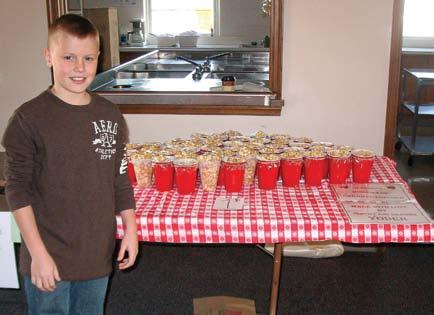
Young entrepreneurs put parable to work
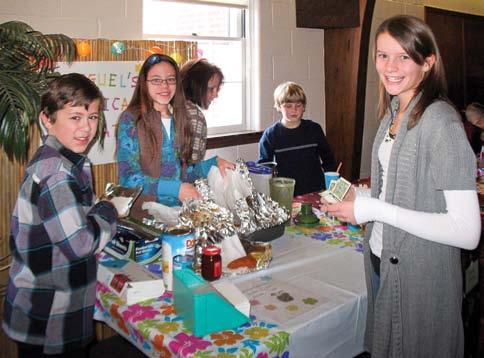
It’s never too early to learn a few things about being entrepreneurs and stewards. Last October, 57 children in third through sixth grade at Blooming Glen (Pa.) Mennonite Church received quite a surprise when they gathered up front for “Moments with the Children.” Each one was presented with a large envelope containing 10 $1 bills.
“The looks on those young faces were priceless, but this was not free money,” says Steven Hunsberger, a member of the church. “The children were also presented with a challenge — to be like the first servant in the Parable of the Talents from Matthew 25 and make money grow.”
The children got to work. A few purchased rakes and cleaned neighbors’ lawns. Some bought ingredients and baked Christmas cookies or made hot chocolate mix.

Popcorn vendor Jeremy Yoder: Lessons in business and sharingOthers bought wrapping paper and started a Christmas present wrapping business. Two sisters made a meal and charged customers to eat at their home “restaurant.” In January the congregation held a Kids Market after Sunday school where the young entrepreneurs displayed and sold their wares — from soup to stationery, potholders to pillows, baked goods to babysitting services and much more — all made by the children. “That was awesome!” said a third-grade vendor later, a sentiment echoed by both young and old who attended. The project concluded on the last Sunday of February when 54 of the children returned with their earnings of $5,167. After paying themselves 10% for their hard work, they tithed 10% and donated the rest to help restore a farmhouse on the church property which is used to lodge refugees and struggling families. “It was a wonderful teaching opportunity, not only about economics, marketing and running a small business, but also about the responsibility we have to return a portion of what we have to God for Kingdom work,” says Janelle Hunsberger, the congregation’s former children’s minister. “Parents reported many dinner time conversations generated from this exercise and we hope that many of the children (and parents) learned a valuable lesson and had fun serving God and others.” “It was a fun project to watch as our children became excited about what they could do to raise money and help the church and people in need,” adds Steve Hunsberger. “My oldest son is 10 and was so excited that he got his brother, age 7, excited even though he was not old enough to participate!”
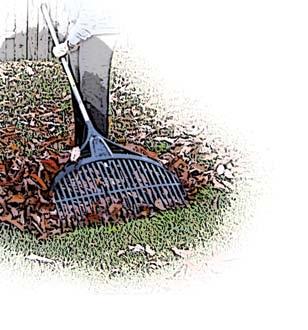
God cares about tires

“If you are a tire company, God cares about the quality of the tires you make. If you are sending e-mail newsletters, God cares about the quality of your content. If you are flipping burgers, God cares about the burgers you flip, the people who flip them with you, the people who sell them, the people who eat them, and the financial exchanges that happen at the cash register. Because we live in a fallen world, it can be hard to find honor in our mundane activities. But honorable work is an offering to God wherever you are, whatever you do. Find the joy of your work again, and thank God for it!” — Marcus Goodyear (no relation to the tire people) in Faith in the Workplace


Mission statements:
A good bead on a weld

“[In] construction season we had to work long days to make up for the winter when deep frost made excavation and grading impractical. During the drive home each day there was a satisfying fatigue that burned bone deep yet provided an intoxicating peace.
“Work is an irreplaceable kind of exercise. It is unique because it yields a product. The product could be food and even a good bead on a weld. The hot days for me were made hotter as a journeyman plumber when melting the lead ingots for sealing the jute in the joints in cast iron sewer pipes. Sweat would drip into the lead pot and create a small crackle as the moisture was absorbed. Work is also a cooperative effort. Many jobs require more than two hands or two skills.... There is something holy about work that sets it apart from other forms of exercise. Not only did God create us to work. He gave us a job and this job gave us meaning.” — Fr. Dale E. Matson in Meditations of a Plumber Priest Overheard: • “To honor God in all we do: by respecting others; by doing good work; by helping others; by forgiving others; by giving thanks; and by celebrating our lives.” — Dacor, kitchen appliances • “To honor God in all we do; to help people develop; to pursue excellence; and to grow profitably.” — ServiceMaster, cleaning, disaster restoration and insect control • “To equip people to make their difference in the world.” — Timberland, outdoor outfitter
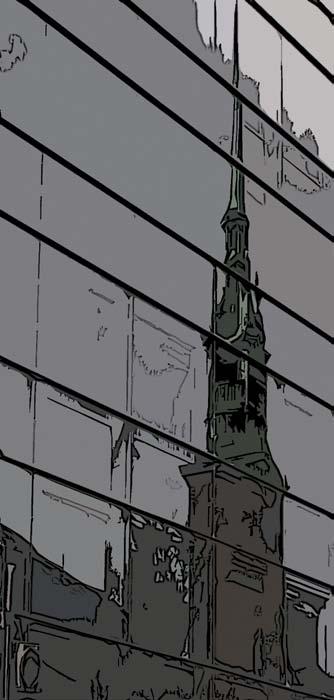
“People will judge you by your actions, not your intentions. You may have a heart of gold — but so does a hard-boiled egg.” — Anonymous quote in the Globe & Mail
Taking cover
“Greenhouse capital” opens arms to visiting farmers from Ukraine
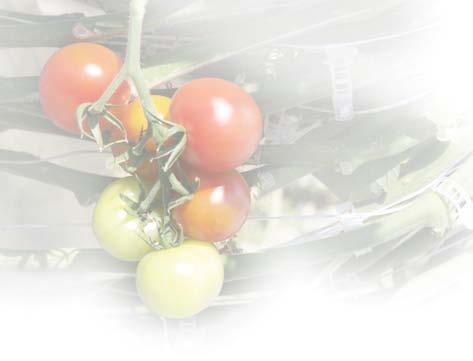
Photos by Steve Sugrim and Irina Antonovskaya
by Linda Whitmore
Farmers participating in MEDA’s Ukraine Horticulture Development Program (UHDP) are poised to leapfrog to new prosperity following a 10-day visit in June to greenhouse farms, buyers and co-ops in Leamington, Ont. With the largest concentration of greenhouses in North America and more than 1,500 acres “under cover,” the Leamington area is known as the greenhouse capital of North America — and the tomato capital of Canada.
The visit, organized through MEDA’s Leamington chapter, gave Canadian greenhouse growers an opportunity to reach across the ocean to lend a hand to fellow farmers in Ukraine struggling to modernize not only their production, but also their whole market system to become more profitable.
Leamington chapter members have shown a keen interest in the Ukraine project, raising $20,000 to help increase yields and incomes for 5,000 Ukraine farmers. They were happy to share their insights and expertise with others who are facing the same challenges they have already successfully overcome.
“The greenhouse technology and operating models in the Leamington area are 20-30 years ahead of Ukraine,” says Nigel Motts, MEDA’s director of agriculture market linkages. “Leamington has gone through the same transformation to new technologies that their Ukraine colleagues are now trying to accomplish. On both sides of the ocean, growers recognize that adopting new technology gives you an edge in the market.”
The delegation included 16 greenhouse growers, UHDP staff and a packed itinerary, with tours of 15 facilities representative of various steps in the value chain that takes produce from farm to table — farms, greenhouses, grower cooperatives, agri-buyers and marketers, a packaging plant, roadside market and distribution centers.
They saw a variety of business models and heard about North American approaches to production, pest control, economics, cold storage technologies, consolidation of produce, marketing, packaging, branding and innovation.
The group learned about advanced greenhouse technologies and saw fully automated operations to emulate,
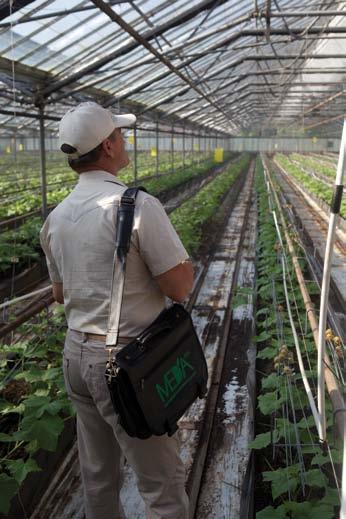
Visiting Crimean farmer Oleksandr Suslov admires a greenhouse full of young plants.
new practices to adopt and new markets to target. They also witnessed the benefits of having supportive banking systems and financing, modern packaging and legal frameworks.
But they were also introduced to a new reality
— of trust, transparency and openness. The group was struck by the cooperation they saw within the Canadian farming industry: how growers and marketers work together to build strong relationships to meet consumer demand. Iurii Goiko, a lead farmer from Zaporizhzhia, said, “The host farmers explained their efforts to develop their businesses and their progress but they also talked a lot about their mistakes, and it gives us a chance to avoid those mistakes.”
The Ukraine delegation was grateful for the support they found on this side of the ocean. When asked about a key take-away from the trip, farmer Sergiy Tur pointed to “the confidence of Canadian farmers that Ukraine farmers will advance quickly in the next 5-10 years.”
Nadia Kompaniets, director of the Ukraine Women Farmers Council (UWFC), was struck by the trust she
witnessed: “It is a pleasure to see how people here smile with their hearts open.”
“I loved to see a living body of agriculture that struggles, suffers and strives — and we saw this on both a micro and macro level,” said Gennadiy Podshyvalov, director of Agro Tavria, a UHDP partner. “Also how external factors impact a situation. It is most important to see this with our own eyes. There are factors that don’t depend on us, but there are some things we can change ourselves.”
Dilyaver Seythalilov, a farmer from Crimea, said, “Before the trip I had certain expectations — new technology, stable government and how people in Canada see their future as being stable. The root of it is the culture.… I really like the culture and how people treated us.”
The visitors were The Ukraine visitors also noted some key differshocked that a ences between farming in Canada and their homeCanadian farmer land. Senior consultant/projwould leave a ect manager Katie Turner, who worked with the tractor in a field Leamington chapter executive to organize the trip, says the Ukraine farmers without a fence. were “dumbfounded that a farmer in Canada would leave a tractor in a field without a fence,” or that farmers here wait three weeks for payment. High levels of mistrust within the Ukrainian agriculture industry and beyond would prevent this from happening there, where farmers are accustomed to closely guarding their assets and have a deep mistrust of buyers.
“Canadian farmers don’t talk a lot about their interactions with the government,” noted Gennadiy Ro-
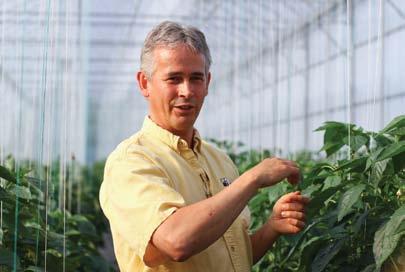
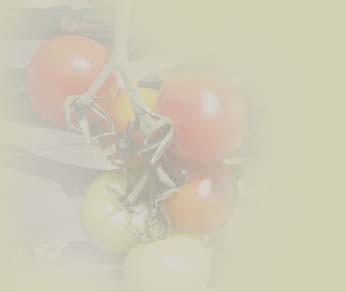
Rob Hansen, owner of Erieview Acres Pelee organic location, describes how he grows red peppers, tomatoes and cucumbers. “It is most important to see this with our own eyes,” said Gennadiy Podshyvalov, head of Agro Tavria, one of UHDP’s key facilitating partners in Ukraine.
manenko, a lead farmer from Zaporizhzhia. “They talk more about their progress, which is very different from Ukrainian farmers.” He added, “Back home, we invest for 1-2 years and expect a fast return; I saw here that our Canadian colleagues are prepared to wait longer. I see the importance of investing in capital assets.”
Farmer Oleksandr Suslov said, “Of course I saw new technologies in production and processing, but here the banks support small farmers and they don’t in Ukraine. We have to count on ourselves.”
Victoria Gontsa of Polly Holdings, an agriculture distribution company, saw things from a marketer’s perspective. “In Canada, there is competition, but they compete within legal frameworks; that is very different from home, which is chaos. From a marketing structure, we in Ukraine
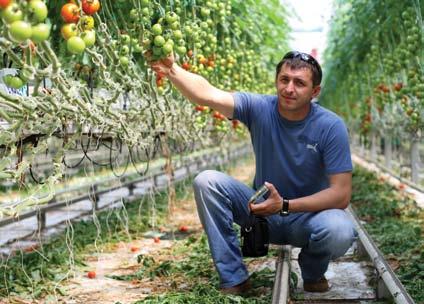
Chapter hosts benefit dinner
Leamington chapter members also hosted a benefit dinner for MEDA’s Ukraine Horticulture Development Project, attracting more than 150 people. The Ukraine visitors were deeply touched by the outpouring of support from the local community. One poignant moment was when people who had personal family ties to Ukraine were invited to stand. More than three-quarters of the audience rose to their feet. Another was sharing part of their Mennonite heritage rooted in four-part harmony, when Dave Epp led the room in singing grace with Praise God from Whom All Blessings Flow. ◆
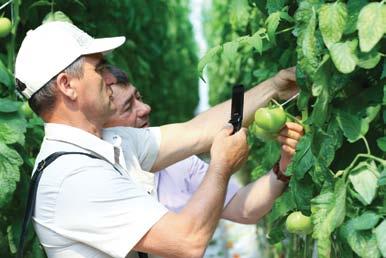
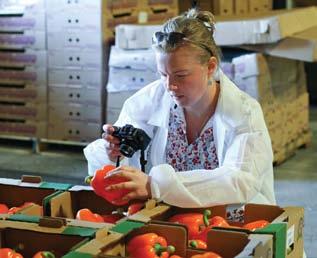
Oleksandr Suslov captures a tomato image to take home to Ukraine at Erieview Acres Pelee location. Standing with him is fellow farmer Dilyaver Seythalilov. Victoria Gontsa gets a close-up of a succulent pepper at Nature Fresh Farms. She is a marketing specialist at Polly Holdings, a distribution company in Ukraine that buys some of its produce from UHDP clients.
have a long way to go.”
UHDP monitoring and evaluation specialist Irina Antonovskaya said her main purpose on the trip was to understand the differences between agriculture in Canada and Ukraine. “I see it is government and financing. All of this is true, but it is not a tragedy (for Ukraine). We should get energized from the examples of our Canadian friends; not all of us will pass it on to our children, but we should try hard regardless.”
“It was a historic trip,” says Turner. “I’m confident there will be many positive outcomes from it over the coming years.”
Trip participants — selected to go to Leamington based on their innovative approach and willingness to
Gender fund helps break “ice of distrust”
MEDA’s Ukraine Horticulture Development Project (UHDP) is boosting its Gender Innovation Fund from $100,000 to $600,000 to be more responsive to women farmers — particularly single mothers and widows. With this increase, the fund could reach 600 women with small grants for technology like rototillers to reduce their labor burden.
UHDP gender specialist Dasha Karpenko and Nadia Kompaniets, director of the Ukraine Women Farmers Council (UWFC), explained to a local fundraising dinner how the project is addressing the needs of women farmers.
“By law, women and men in Ukraine are equal,” said Karpenko, “but in reality kitchen gardens may be a woman’s only income opportunity.”
The project is working with UWFC to increase women’s entrepreneurial capacity with seminars on legal issues, bank loans, taxation, agricultural technology, agribusiness, business plans and profitability.
UWFC is growing rapidly: From only nine members a year ago, the group now has 250 and could add another 150 by year’s end.
Kompaniets reported their work’s biggest benefit is to bring together and mentor women from different communities and various backgrounds.
“If you teach a woman, you teach a community,” she said. “What they learn they pass on to everyone in the community — family, friends.”
The Gender Innovation Fund — essentially a small grant program — offers seed grants to women to start a garden. “These women are single or widowed; they are poor and have the fewest opportunities,” said Kompaniets.
“These grants help to break their ice of distrust,” she added. “You see it in the tears in their eyes upon receiving a piece of equipment that can be managed by a single woman. It could be drip irrigation, seeds, a rototiller, etc. They may start with a strawberry patch; it’s just a small area, but already has a huge impact on their lives.” — Linda Whitmore

adopt new technologies before they see proven results – were already showing signs before they returned to Ukraine of what ideas they would like to put in practice.
Nickolay Gavrylyuk, vice-president of the Association of Farmers & Land Owners of Crimea, said, “We have to design better, more consolidated sales models.”
Micha Dzhorkashvili, a large farmer from Zaporizhzhia, said, “We have to introduce new infrastructure so people can use the new technology.”
Others are focused on sharing what they have learned. “Information is key,” noted Nadia Kompaniets, “and I will relate all the information about the trip to the UWFC members.” Nickolay Gavrylyuk plans to share infor-
UHDP results so far

MEDA’s Ukraine Horticulture Development Project (UHDP) is showing positive results for its 4,000 clients. A recent survey shows: • 19% increase in incomes; • Target crops — greenhouse vegetables, table grapes and berries — have produced positive yields and revenues; • 30% of project farmers have purchased agricultural assets such as sprayers, drills and rototillers in the past year; • 73% have successfully applied what they’ve learned; • 20% increase in participation in marketing consolidation activities designed to improve prices, reduce costs and share transportation and storage facilities.
UHDP field project manager Steve Wright told a Leamington benefit dinner that Ukraine’s rural areas are in a transition period. “There has been a big shift in populations to urban areas. Some rural places were dying as young people left for the cities, but this project is giving youth some reasons to stay.”
He added that Ukraine, the former breadbasket of Europe, is now a net importer of fruits and vegetables. “I hope that through this project we will leapfrog some steps – from Leamington 50 years ago to today’s greenhouses. Access to cold storage is among the innovations we are introducing through UHDP.
“Farmers are also selling in larger batches through consolidation groups. Six clusters produced 800 tons of produce last year. This year, we estimate 4,000 tons will be grown and sold at premium prices. That makes a huge impact.
“A huge barrier at the beginning of the project was mistrust: Many farmers did not believe us at first – they need to see to believe. Now they are starting to believe that real change and future prosperity is possible, through their own hard work and new skills acquired through UHDP.” — Linda Whitmore mation about the new technologies he witnessed through seminars, articles and newsletters. Oleksandr Suslov added, “I will write to the agriculture magazine in Ukraine called Niva (Field) to tell them about the trip.”
Nigel Motts, who recently returned from Ukraine, reports two greenhouse farmers from the tour are now planning to experiment with hydroponic growing using a shredded coconut husk medium. “There are also discussions of a possible internship with a greenhouse operation in Leamington for a Ukraine agricultural college student, as well as a follow-up visit to Ukraine by the Leamington hosts targeted for next spring.
“This experience offers food for thought for MEDA chapters and supporters wondering how they can become more engaged in MEDA’s work,” he says. “It has been a positive learning opportunity for all of us.” ◆
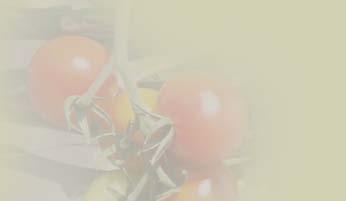
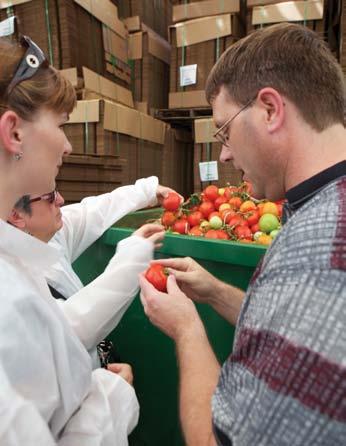
Brian Norg of Nature Fresh Farms explains the fine points of tomato production to Dasha Karpenko, UHDP gender specialist.
Linda Whitmore is MEDA’s manager of communications.
Get involved?
Ukraine was once the breadbasket of Russia. Mennonite farmers tilled the fertile soil, producing bountiful crops. Today, farmers in Ukraine struggle in the aftermath of Soviet collective farming and the recent global recession. Through MEDA, you can help smallholder farmers boost yields, feed their families and communities, and tap the potential of this rich land. To keep up with the latest, go to www.meda.org ◆
Cool savings
Going green can save the environment — and money, too
by Nelson Longenecker
When David Hollinger started Four Seasons Produce in 1976 with a few trucks and a 5,000-square-foot warehouse, reducing costs was critical to survival. Thirty-five years later, Four Seasons has become one of the largest independent produce wholesalers in the U.S., shipping almost a million cases of produce and logistics product monthly.
The company’s focus on cost reduction has continued with a variety of energy-saving strategies. As a result, the company has become an industry example in reducing energy use in cold storage facilities. To us, this is a matter not only of good business and sustainability, but also of Christian faithfulness.
Four Seasons moved in 2004 into its current distribution center in Ephrata, Pa., which includes nearly 200,000 square feet of cold storage space. Very soon thereafter it launched new initiatives to improve energy efficiency and reduce costs. The savings were significant: • a 1.5 million drop in annual kilowatt-hours since 2006; • a 29% drop in natural gas usage; • more than $200,000 annual savings in energy and waste costs; • 2,400 less tons of carbon dioxide emissions annually; • 1.4 million gallons of water saved annually, a 21% reduction; • an 88% waste diversion rate through recycling in 2010; and • elimination of more than 1,200,000 truck fleet miles from 2007 to 2009 through routing and delivery improvements, a 21% reduction.
How, exactly, did we achieve these results?
Electricity
A big ticket item in a cold storage operation is electricity. We entered into a partnership with ENERGY STAR, a joint program of the U.S. Environmental Protection Agency and the U.S. Department of Energy to help measure energy performance, set goals and track savings. Commercial buildings that earn the ENERGY STAR label, such as the Four Seasons distribution center, use an average of 35% less energy than typical buildings and also release 35% less carbon dioxide into the atmosphere. Four Seasons Produce was the first warehouse in the U.S. to earn the ENERGY STAR label when it received a rating of 82 (out of 100) in 2008. Beginning in 2006 we reduced electricity consumption by using integrated refrigeration software that monitors and controls power use, limiting peak demand. Four Seasons partnered with EnerNOC, an energy management firm, to develop a demand response program that pays organizations to voluntarily reduce energy Last year more than use during times of peak demand, thus reducing the need to construct new 42 million pounds of power plants. Numerous utilities across the country waste were diverted offer such programs. In our case, we participated in a from landfills. program offered by PJM Interconnection, an electric Four Seasons photo grid operator for a region including 13 states and the District of Columbia. Four Seasons receives about $25,000 a year for its participation. How does it work? During short-term events to balance electrical demand across the grid, Four Seasons facilities staff receive phone calls and e-mails two minutes before the company’s refrigeration systems are shut down remotely. “Events” last about 10 minutes, and when they are over, the refrigeration systems go back online automatically. Room temperatures remain within 1°F to All that space, all that produce make an ideal 2°F of the set-points, so the testing ground for energy reduction. produce is not affected.
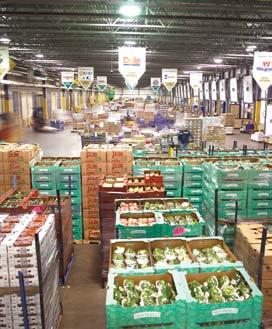
Four Seasons was the During an emergency load response event, first warehouse in which occurs primarily during the high-demand the U.S. to earn the summer months, Four Seasons might be called ENERGY STAR label. upon to reduce its energy use for longer periods to avoid a brown-out or shortage from its energy provider. These events typically occur once a year or less. A back-up generator powers lights and computers to reduce energy use during an emergency load response event.
Refrigeration is not turned off during the longer response events. We retain full control and can choose to
Pleasing God
God has a calling for each believer — and a purpose for each of our gifts. That is true whether we are accountants, architects, artists, business leaders ... or worship leaders. My gifts happen to be in the arena of business. And when I exercise those gifts — to paraphrase Eric Liddell in the movie Chariots of Fire — “I feel His pleasure.” When we operate as stewards — reduce our resource use and find more sustainable ways to operate a business — it pleases Him. In my youth I gained a tremendous sense of wonder about nature and the comLongenecker plexities of our environment. The result for me through the years has been a growing delight in God’s creation and an increased capacity to worship Him as the creator. This has also resulted in a strong conviction that God owns all of it (the earth is the Lord’s!). In a very real way, my passion to do business more sustainably is one way that I worship as I work. — Nelson Longenecker
Four Seasons photo
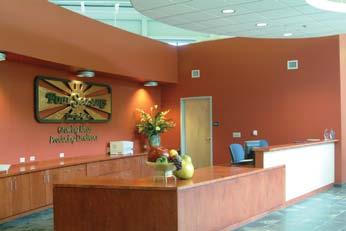
Artificial lighting in the office is supplemented by daylighting.
override any shutdown without penalty.
During a demand response event, Four Seasons’ energy curtailment ranges from 400 kilowatts per event during the winter to 1,000 kilowatts during the summer.
The curtailment service provider installed a metering system at our warehouse and worked with us to identify these energy curtailment strategies.
We retrofitted our lighting in the warehouse, replacing metal halide lamps with T-8 fluorescent lamps, which have increased lighting levels by 40% and decrease the refrigeration cooling load. This has reduced annual electricity use by more than 900,000 kilowatt hours. Energy savings paid for the project in two years. A recent project involved replacing similar lights in our parking lots with induction lights, yielding more than a 50% reduction in energy use — and with a utility rebate, also a payback of two years.
We retrofitted the Four Seasons office with HVAC controls in 2009, adding carbon dioxide sensors and ventilation controls for heating and cooling. Natural gas and electricity savings to date have placed this project on track to match the payback period of the lighting retrofits.
Water
To conserve water we have tried several methods to treat the cooling tower water. We initially tried a nonchemical approach, but this was inadequate to handle the local water, which is extremely hard. ☞
Now a contractor treats the cooling tower water with limited use of chemicals. This concentrates the water (via evaporation) to one-sixth of its original volume before it is flushed and replaced with fresh water. If the water is not treated, mineral deposits and bio-film can coat the surfaces of the cooling system, reducing its effectiveness and increasing water and energy costs. The changes have reduced annual water use by 1.4 million gallons.
Waste
In 2000 we started a waste diversion program to recycle or compost materials ranging from rubber tires to produce waste. In 2010 alone, this diverted more than 42 million pounds of waste from landfills.
Co-mingling (a nonsorting recycling system) simplifies recycling and increases employee productivity. This has reduced waste and led to a recent milestone of not having to remove a single trash container from the 262,000-square-foot facility for almost a month. What does a company like ours do with the leftover wax cardboard that we need to ship moist or iced products? We used to send it to landfills, but in 2002 we found a company that would recycle it at a fixed cost per load. In 2008 Four Seasons found a Georgia company that uses wax cardboard to make fireplace logs. That company has an empty truck coming out of the northeast that picks up the cardboard at no charge.
Discarded fruits and vegetables not suitable to be donated go to a local farm for feedstock. We considered composting, a more common practice, but decided that feeding it to animals was more cost effective.
Future projects may include LED lights to replace current light bulbs, an ice storage system for shifting the building’s peak energy use, and solar panels for use on our 240,000-square-foot roof.
Besides saving resources and money, sustainable practices have drawn new customers.
Our own G.R.E.E.N! Team (Gaining Resource
and Energy Efficiency Now!) supplements our sustainability efforts and education. The team is composed of associates from each department who identify new ways to improve. Besides saving resources and money, we’ve found our practices attract customers who want to buy produce from sustainable companies. This motivates us to find even more ways to save energy and resources.
We recently joined the EPA’s WasteWise recycling program, which helps its partners reduce and recycle solid waste and selected industrial wastes. Four Seasons has also recently become Green-Plus certified, based on a “triple bottom line” assessment by the Institute for Sustainable Development located in North Carolina. ◆
Four Seasons photo
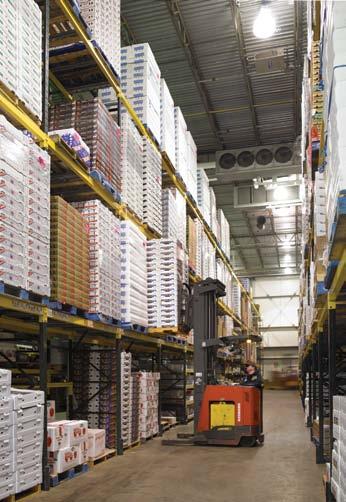
7,000 pallets across 22 aisles, all needing sustainable refrigeration.
Nelson Longenecker, a member of the MEDA board of directors, is vice-president of Business Innovation at Four Seasons Produce. A longer, more detailed version of his article appeared in the 2010 summer issue of the engineering magazine, High Performing Buildings.
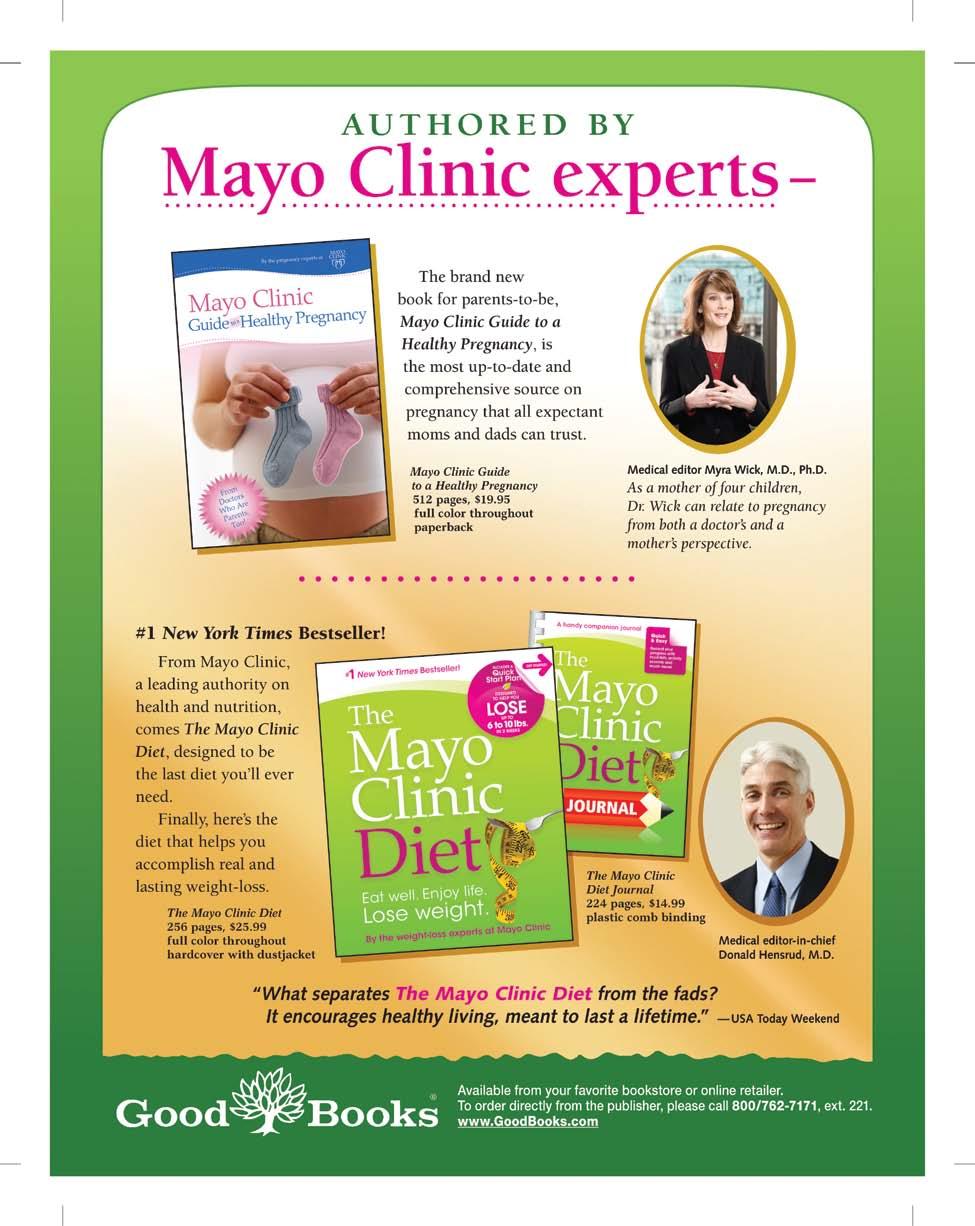
MEDA’s next step in global investing
Shift in focus puts Sarona in major leagues
MEDA has taken a bold step to vault Sarona Asset Management Inc. (SAM) into the premier leagues of impact investing.
Sarona provides a bridge between private capital markets and investment opportunities to serve the poor in emerging and frontier markets. It manages the $15 million investment portfolio for MEDA’s Sarona Risk Capital Fund and creates other impact investment funds which, together with MicroVest funds, amount to some $180 million in assets under management.
“It has been a leader in creating the global impact investment industry,” says MEDA president Allan Sauder. “Impact investments create positive impact beyond financial returns — socially, economically and/or environmentally. Investment in developing countries has been the key to reducing poverty levels in recent years.”
As SAM has grown, MEDA leadership concluded that some adjustments would help to reduce the risk to MEDA, while helping Sarona fully achieve its mission of steering private capital to poor communities in developing countries. Accordingly, MEDA recently sold 90 percent of SAM to private management and ownership. MEDA retains a minority ownership stake in order to ensure that its mission continues to be fulfilled.
The shift to private management is also expected to increase appeal to institutional investors who are more comfortable with a for-profit company.
SAM president Gerhard Pries believes the new structure also will help attract management talent, as many senior professionals prefer a familiar for-profit setting. “Moreover, some investors require the managers to be personally invested and have downside risk, which was not possible under the MEDA ownership,” he says.
“The new structure allows us to build the work at a pace and to a level that wasn’t possible before. We can become yeast in a much larger bowl of dough, and achieve MEDA’s mission to a greater degree than was possible before.”
“The shift,” adds Sauder, “will broaden MEDA’s impact on the poor for many years to come.”
The transition will create a registered impact investment asset management company that can grow assets under management significantly and bear the cost and risks of registration with securities and exchange regulators.
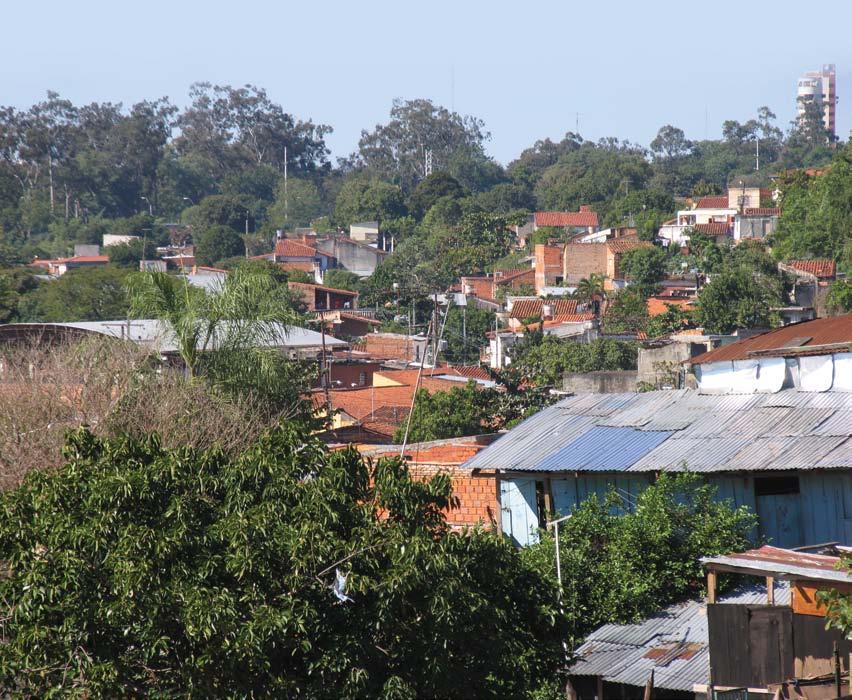
Ray Dirks photo
The Sarona group of funds and related com-
panies is named after MEDA’s first investment in 1953. At that time, a partnership was formed between MEDA and Mennonite farmers in Paraguay to build the cattle industry and set up milk distribution facilities. The project was named Sarona Dairy after the biblical “plain of Sharon.”
This project marked the launch of MEDA, an organization created by North American Mennonite businessmen to respond to the need for capital and to share risk with the poor by investing in the private sector.
The Paraguayan partners eventually bought and paid for all of MEDA’s shares, which created a pool of capital that MEDA could use for other “We can investments to benefit the poor around the world. Today, MEDA become yeast continues to invest those 1953 dollars. in a much This pool of capital operated under various names until larger bowl 2000, when the Sarona Global Investment Fund was established as a legally separate famof dough.” ily of companies to allow private
investors to serve the poor through investment-based development, managed by MEDA Investments Inc., a wholly owned subsidiary of MEDA.
In 2004, MEDA and two other partners created the MicroVest family of funds using capital from the Sarona Global Investment Fund, to bring commercial capital to microfinance institutions in developing countries.
In 2007, the MEDA-owned fund was renamed Sarona Risk Capital Fund, reflecting MEDA’s interest in investing in early-stage companies and funds that benefit the poor, and inviting private capital to follow.
In 2010 MEDA transferred its investment fund development mandate to a new MEDA-owned for-profit subsidiary, Sarona Asset Management Inc. (SAM) headed by Gerhard Pries (former MEDA CFO and director of investment fund development). SAM managed the Sarona Risk Capital Fund on behalf of MEDA and created the Sarona Frontier Markets Fund 1 LP, with 34 limited partners, to invest in funds around the world that invest in micro, small and medium enterprises.
By then it was becoming clear that MEDA was on the cusp of a new wave of global interest in impact investing. Individual investors and increasingly Wall Street institutional investors were seeing the potential for investments that make a difference in the developing world and yield commercial returns. The Sarona brand was becoming well-known in the impact investment world, based partly on MEDA’s nearly 60-year history in the field and mostly due to SAM’s work in promoting the concept worldwide.
The new company will seek to become regis-
tered with the Securities and Exchange regulators, and continues to provide management services for MEDA’s Sarona Risk Capital Fund under a revised management contract and a trademark licensing agreement. MEDA wishes to limit its potential future liability in a registered for-profit investment company by reducing its stake to a minority position.
“We believe that this change is a necessary step in creating an industry-leading impact investment company that MEDA will be able to point to with pride,” says Sauder. “We also believe that it is closely in keeping with MEDA’s initial mandate to respond to the need for capital and to share risk with the poor by investing in the private sector.”
He adds that SAM envisions a portfolio that could exceed $1 billion in assets under management.
The Sarona trademark was registered in June. Investment decisions for the Sarona Risk Capital Fund are made by the directors of Sarona MEDA Investments Inc. (SMI), a wholly-owned subsidiary of MEDA. Directors of SMI are appointed by the MEDA board. ◆
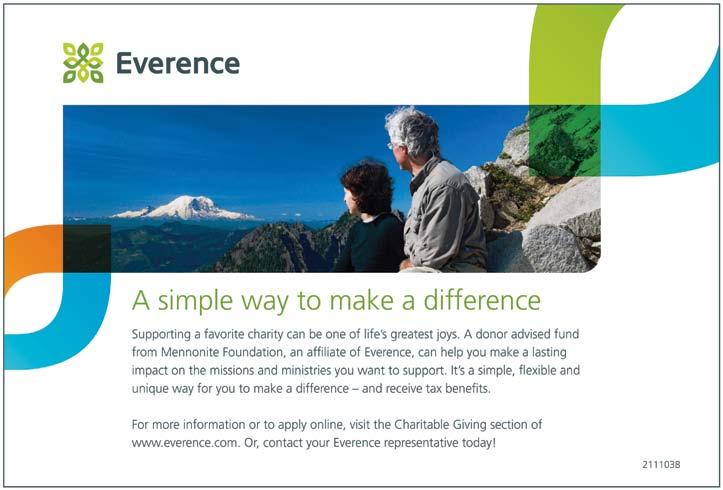
An entrepreneur for all seasons
Remembering Aaron Klassen (1924-2011)
by Jack Dueck
The word entrepreneur is today most often defined in terms of commercial business. It actually originates with an Old French word entreprendre: to undertake an enterprise. It connotes a person in possession of an idea and a willingness to engage its risks and its outcome. The social entrepreneur, for example, desires to improve, even transform conditions. The Christian entrepreneur is biased to pursue issues of biblical value and meaning, while consistently addressing the status quo. The Christian entrepreneurial stance resonates with dramatist George Bernard Shaw’s character who declares: “Some people see things as they are, and tell me why; I dream of things that never were, and say why not.”
In our conversations Aaron Klassen repeatedly differentiated between prejudice and bias. Prejudice, he maintained, was based on prejudging; bias, for him, was a particular mind-set, a template for living. With his faith confession and Christian baptism at age 21, his living became a biased and entrepreneurial pilgrimage. One associate noted that Aaron lived his faith
in terms of prophet Micah’s bias: doing justice, loving kindness and walking humbly. Aaron agreed with the declaration by a character in Canadian novelist Rudy Wiebe’s The Blue Mountains of China: “Jesus says, in his society there’s a new way for man to live: you show wisdom, by trusting people; you handle leadership, by serving; you handle offenders, by forgiving; you handle money, by sharing; you handle enemies, by loving; you handle violence, by suffering. In fact you have a new attitude toward everything, toward everybody. Toward nature, toward the state in which you happen to live, toward women, toward slaves, toward all and every single thing. Because this is a Jesus society. And you repent, not by feeling bad, but by thinking different.”* Over the years Aaron brought his Aaron Klassen at last fall’s MEDA con- entrepreneurial zest to many positions. To vention in Calgary. name a few: farmer, Bible school teacher, interim editor of the Mennonite Reporter, university scholar, managing Provident Bookstore, MCC board and service, work with MEDA, board member at Conrad Grebel College, realtor, preacher, Stirling Ave. Mennonite Church committees, operating a group home *Rudy Wiebe, The Blue Mountains of China (Toronto: McClelland and Stewart, 1970), 215-216, Italics in the original

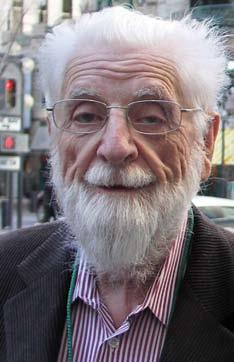
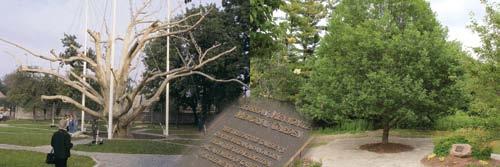
The past is part of the present: Thanks to Aaron Klassen, an acorn from the dead “Chortitza oak” in Ukraine (left) now thrives on the Conrad Grebel campus (right).
for boys, and numerous voluntary services — the list extends.
For this entrepreneur, opportunities constituted a calling. A few Sundays before his death, he shared his life’s testimony in his Stirling Avenue Mennonite Church. Noting that in his faith pilgrimage he was not always sure of the will of God, opportunity in the form of a need was for him a calling. His lived bias became a patchwork quilt of engagements in which to live out his part in the Jesus society; making little distinction as Christian entrepreneur between the secular and For Aaron, God the sacred. He was the rare real estate broker was entrepreneur selling properties by day and reading Jesus, Tilpar excellence lich, Yoder, Reimer, et al at night. — both in the Aaron found the Christian entrepremiracle of life in neur calling a privilege and a pleasure. These were the basis for his all creation and in long-term support and delight in the purpose Christ “making all and work of MEDA, an organization founded things new.” by entrepreneurs for fostering the entrepreneurial spirit among economically disadvantaged. For the last MEDA convention he attended in Calgary (2010), Aaron had paid the travel and registration for a young man interested in business; it was, according to family members, a life-changing experience. In MEDA involvement, Aaron encountered the joy entrepreneurs had and shared in being Christian entrepreneurs. For Aaron, God was entrepreneur par excellence — both in the miracle of life in all creation and in Christ “making all things new.” And he, Aaron, found himself a joyous participant.
Standing at his bedside, he unconscious and
breathing his last, an urging question attends my grieving over loss: How does one weigh the spirit of a loved friend deceased? Then, in subsequent days, stories provide incarnational lineaments.
Aaron’s relationship with young people, in and outside the church structure, is legendary. For its annual silent auction, Stirling Ave. Mennonite Church again included the item: Coffee time conversations with Aaron. When Aaron died shortly before the recent auction, some suggested the item be removed — he is after all no longer with us. But someone said “Let’s leave it on and see what happens.” Bids at auctions customarily start at the five or ten dollar level and then move up a bit. When the Aaron item was announced an uncomfortable silence seized the noisy crowd. Suddenly a young man, whom Aaron had befriended, shouted: 100 dollars! The contagion spread until numerous other young people bid $100 each. All were young people with whom Aaron had lunched, visited, supported, counseled, humored and, above all, loved. The sale of the Aaron item resulted in the highest sale of any in the entire auction. One youth, eyes glistening, told me “that will be some coffee time, having Aaron present with us in stories, moving and humorous.”
A former president of Conrad Grebel College invited Aaron to breakfast. When asked, “Are you going?” Aaron retorted, grinning, “Sure, he’s paying!” At breakfast with Aaron, the president comments that the 700-year-old iconic oak tree in Chortitza — the former home of Mennonites in Russia — is dying. Hearing of its imminent death someone had brought acorns from that ancient of days and planted them in Canada. Some sprouted into new life becoming healthy saplings. The president invites Aaron to make a donation to purchase the tree, to move it and to plant it on the Conrad Grebel campus. When I asked him about it Aaron chortled: “That was an expensive breakfast for me.” But then he added, “You know, the past is never a dead past, filed away in archives. The past is really part of our present.” The passing of the old oak and the new life of the young oak were for Aaron metaphors of old forms and isolation passing and the flowering of a new spirit among Mennonite Anabaptists the world over.
After his death I visited the young oak, sat at the
bench by the plaque and enveloped by gratitude over how Aaron’s people — although leaving Russia in the 1870s for reasons to maintain a secluded, conservative lifestyle — evolved, like Aaron himself, from being die Stillen im Lande to becoming, in Menno Simons’ words: All things to all people.
On one of our visits he offered to show me where he had been a broker selling lots in upscale Hidden Valley, Ont. Friendly greetings echo around the visits: the invitations to coffee, the lively rememberings, were all about families, relationships, health, the stuff of living, few about real estate. A Muslim couple, obviously affectionate of this Mennonite, opens doors to tea. During the visit the lady notes that she’s nudging her husband to finally — Before he’s too old — leave his business for a few weeks to make the long-intended trek to Mecca. “So Aaron,” she asks, “what do you think?” Turning to him Aaron says: “Follow your heart; you really should go on this spiritual pilgrimage.” Later I nudge Aaron: “What a stretch: a Bergthaler Mennonite encouraging a Muslim real estate client to make the religious pilgrimage to Mecca.” When I add: “You didn’t mention Jesus once” he smiles but says: “Timing is all. From previous conversations with him, I’ve recognized his spiritual quest. But more important, Jesus should never be used for crude manipulation.” Before me in line at the funeral home visitation is a man dressed in outdoor living clothes, oversized duffle coat, baggy pants, knapsack, rumpled hair and missing a few teeth. From the coffin he moves to each mounted picture and then stands at length at the DVD — tears flowing.
In conversation with family he noted: “I’ve known him since I was a teenager. There were some difficult times. I loved bikes and cycling, so I used to camp out a lot. Lots of people used to order me off their property, but Aaron was different. When I would camp out along the river’s edge at Hidden Valley, he would come over and speak with me. At our first meeting I asked him: ‘Do you want me to leave?’ I still remember, clearly and fondly, how he told me that I might come and go anytime I wanted, because, as he put it, ‘This isn’t my land… this is God’s land.’ Aaron believed in me.”
Writing in the Memories Book, Raymond offered this loving farewell to the man he first encountered by the Grand River years ago:
“Well, dear Aaron, I know that now you are in God’s land.” ◆
Jack Dueck is a Canadian writer and story teller living in Waterloo, Ont. He may be reached at eajdueck@gmail.com
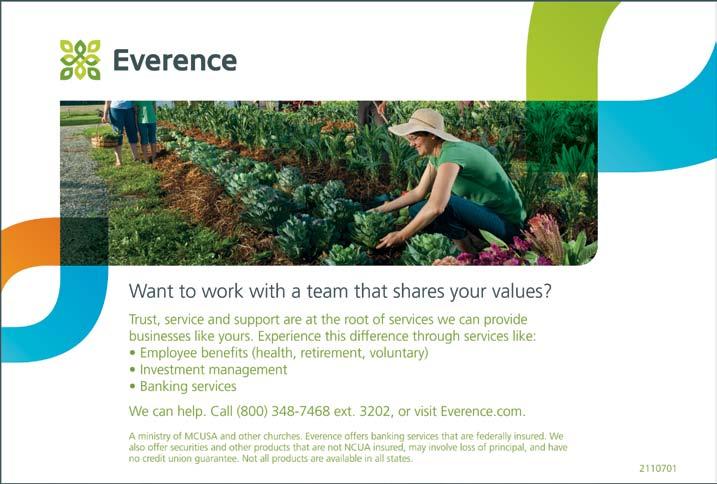
What’s your company’s vision?

The Bible says, “Write the vision and make it plain...” (Hab. 2:2). What could this mean for a company? Many firms have mission statements — usually short, pithy summaries of what they want to achieve. Others also have a longer declaration of vision, sometimes called core values, which lays out the spiritual and social principles that owners hope will undergird or animate their business style. Here is one such statement, compiled by a company in the food production business (feel free to send us yours).
We envision a company that:
• meets food needs for this genera-
tion and beyond. Our basic commitment is to produce nutritious food on a sustainable basis. As stewards of the land we feel responsibility for larger environmental issues such as the preservation of soil and water under our care. • is an industry leader. We seek to model creative, energetic and forward-looking management that brings pride and profits to our stakeholders. We do not grow for the sake of growth nor do we place artificial limits on our size or scope; rather we seek and seize good opportunities to expand our sphere of leadership and stewardship. We are prudent risk-takers — innovative but not reckless. • works in partnership with others. As agricultural entrepreneurs, we create opportunities for shareholders, employees, partners and investors so all can utilize their abilities to earn a meaningful livelihood and enrich our communities. We exercise leadership and generate opportunities through a network of efficient economic units and strategic alliances that empower one another, build mutual strength and reduce risks. In doing so, we seek to avoid conflicts of interest, at the board, management and staff level; where such conflicts cannot be avoided, we forthrightly identify them and seek to minimize their adverse effects. • has management depth. Our success should not depend on a few key people. We seek to systematically increase the knowledge base of our employees at several levels as a buffer against sudden personnel changes, should they arise. • practices innovative agriculture. We want to develop expertise, both corporately and among our staff, to keep us on the leading edge of our industry. We cultivate relationships with research institutions in our field and allocate time and resources to applied industry research that
will enhance our productive capacity. We value and promote critical thinking that strengthens our role as a model of innovative and sustainable agriculture. We value and seek to uphold our tradition of serving the wider industry through regional and national leadership involvements.
• is financially
robust, not unduly vulnerable to industry or climatic dips. Our approach to matters of finance is one of fiscal realism; our analysis of new ventures utilizes mature discernment, full-cost accounting, a hard-headed calculation of risks, and follows financial policies set down by the board.
• shares with oth-
ers. In accordance with our policy on donations, we share profits not only with employees and senior management but also with wider community and charitable causes — local, regional and global.
• practices Christian
ethics. Our dealings with stakeholders (including shareholders, employees, partners, investors, colleagues, customers, suppliers and competitors) are grounded in biblical teachings of integrity, fairness, decency and respect. Our cropping practices, technology and land use take seriously the impact on future generations. ◆



